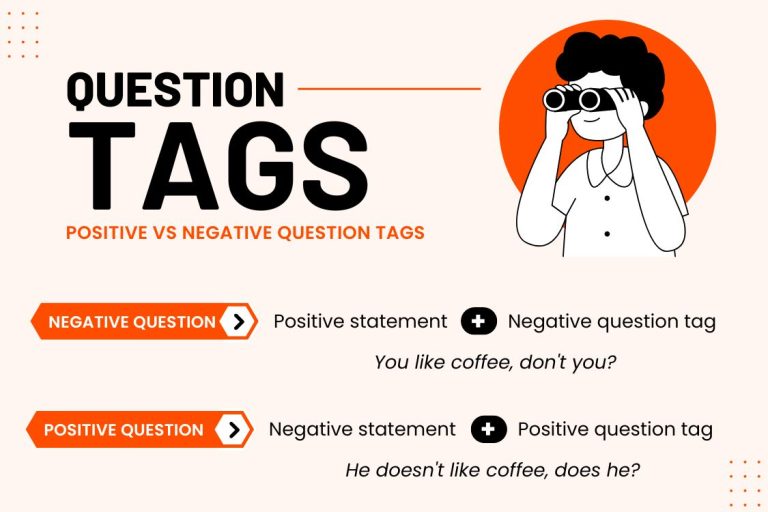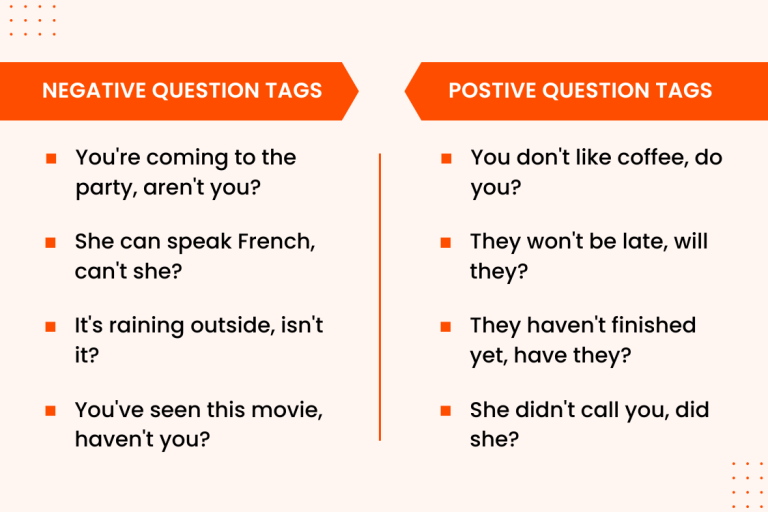You Want To Learn Question Tags, Don’t You?

Examples of Question Tags
Question tags are short questions at the end of statements. They use an auxiliary verb and a subject pronoun to flip a statement into a question.
Here is the structure of a question tag:
Positive statement + Negative question tag
Negative statement + Positive question tag
We typically add a comma before the auxiliary verb. Then, at the end of the statement, we add a question mark as a punctuation mark.
Here are some examples of question tags in action.
1. “You’re coming to the party, aren’t you?”
2. “It’s raining outside, isn’t it?”
3. “She can drive, can’t she?”
4. “We should leave now, shouldn’t we?”
5. “They haven’t left yet, have they?”
Do you notice any similarities? First, they all turn simple statements into interactive questions. But these question tags also seek agreement from the listener. This means they invite the listener to respond and engage in the conversation.
Rules of Using Question Tags
When using question tags, always match the tense and auxiliary verb of the main sentence. For example, if you say, “She is going,” add “isn’t she?” to make it a question tag.
Use positive question tags with negative sentences like “He doesn’t like coffee, does he?”. But for negative question tags, make sure you use positive sentences, such as “You like coffee, don’t you?”
- Positive question tag – “He doesn’t like coffee, does he?”
- Negative question tag – “You like coffee, don’t you?”
When confirming information, your voice falls at the end: “It’s warm today, isn’t it?” But if you’re really asking, your voice goes up: “It’s warm today, isn’t it?” This small change in tone tells the listener what you’re expecting.

Special Cases in Question Tags
Learn how we use question tags in real life with these examples. Here are some special cases for using question tags:
- With positive “I am”: The question tag is “aren’t I?” instead of the expected “am I not?” Example: “I’m helpful, aren’t I?”
- With imperatives: Use “shall we?” for suggestions. Example: “Let’s take a break, shall we?”
- With “let” not involving the speaker and listener: Use “will you?” Example: “Let him speak, will you?”
- With “there is” and “there are”: The tags follow “isn’t there” or “aren’t there”. Example: “There’s a problem, isn’t there?”
- With “nobody”, “somebody” and similar pronouns: Treat them as the plural for the tag. Example: “Nobody knows, do they?”
- When using “used to” to describe past habits: The tag follows “didn’t”. Example: “You used to swim, didn’t you?”
So as you can see, there are quite a few nuances of using question tags, aren’t there?
Practical Examples and Usage
Here are some common mistakes using question tags.
The subject pronoun must match (“you” -> “aren’t you”). The auxiliary verb should agree with the subject, making “aren’t you?” the correct form.
The auxiliary verb must match (“can” -> “can’t she”). Remember that the tag should reflect the opposite form, hence “can’t” instead of “can”.
Remember to match the modal verb “will” in both the negative statement and the question tag. So, the big takeaway is that most mistakes in question tags often come from mixing up the verb or pronoun.
The Role of Question Tags in English Communication
We use question tags to check if we agree with the other person. They also help make conversations more engaging by asking others for feedback. For non-native speakers, they can also help you sound fluent amongst your peers.
Now, it’s your turn to try them out in your everyday talks. Give question tags a go in your everyday life. Do you have any questions? Let me know in the comment section below.
